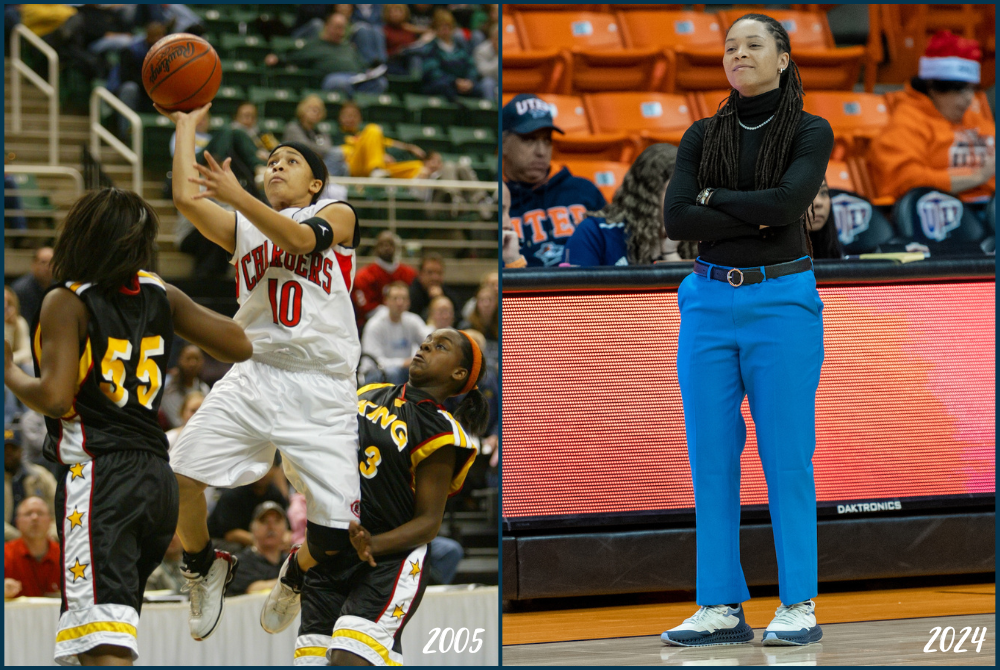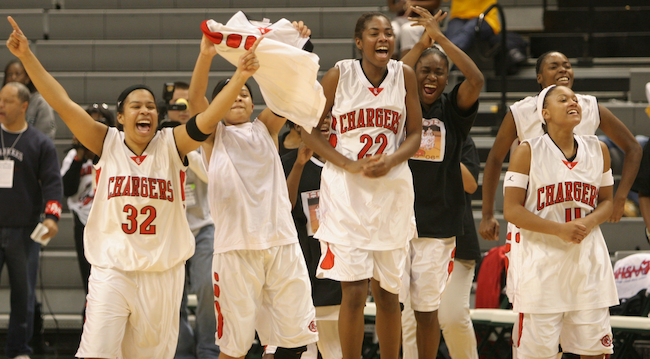
Making (Health) Histories Every Year
July 23, 2015
By Rob Kaminski
MHSAA benchmarks editor
Tom Minter, recently retired from the MHSAA as assistant director, wore many hats while serving the Association and donned official’s gear in numerous sports outside of business hours.
But one of his finest refereeing efforts might have come during the 2009-10 and 2010-11 school years when he guided approximately 60 individuals representing 25 medical and professional organizations through an arduous process to upgrade the antiquated Physical Form to what is the standard today: the Pre-participation Physical Examination/Health History Form.
The form highlighted Stage 1 of the MHSAA’s 4 Hs of Health and Safety – Health Histories – and the current form is much more comprehensive, answering questions previously not asked during the quicker, more brief, evaluations.
Sudden cardiac death claims the lives of more than 300 Michigan children and young adults between the ages of 1-39 years annually. Yet, many of these deaths could be prevented through screening, detection, and treatment. One such way to detect high risk conditions that predispose to SCDY is through pre-participation sports screening of student-athletes, and the current physical form provides a mechanism.
While much more detailed, schools report that parents are more than willing to take the extra time and effort to complete the lengthier version.
“When the expanded form came out, people kiddingly made comments about its length; yet in today's day and age everyone understands we need all the information we can cultivate regarding health histories of our student athletes,” said Mark Mattson, athletic director at Traverse City Central.
Down state, feelings have been similar. “We don’t have a problem at all here,” said Anna Devitt, athletic secretary at Hartland High School. “Our parents take care of it, and haven’t balked at the length at all.”
Both agree, and are joined by many others across the state, that the next logical step is for the form to be converted to a fillable, online document so that records can be accessed by those in need via mobile, laptop or desktop.
Thus, in the “No H left behind” mantra that the MHSAA has assumed, an electronic option of the Health History form is in the early planning stages.
“As an increasing number of our schools strive to be ‘paper-free,’ or at least as much so as possible, it is time to re-invent the delivery method for perhaps our most downloaded or distributed document,” MHSAA Executive Director Jack Roberts said. “Once again, as we move forward with our ‘Heart’ initiative for the coming school year, we are also intent on bringing other projects up to speed.”
The masses are certainly enthused.
“That would be heavenly. An online version that would prevent people from submitting the forms until all the required information was in place would be fantastic,” said Mattson, who has had to turn back, or hold out students while waiting for completed forms, whether at Marquette, Maple City Glen Lake, or his current post in Traverse City. “It’s always been the same; people move too quickly and overlook required fields. It would prevent two things: one, having to hold kids out while waiting for a signature, and two, prevent parents from having to drive in to the athletic office to sign or fill in that last field. We’d know we were getting a completed form.”
At Hartland, where athletic director Jason Reck created an online emergency contact form, a system is in place which allows coaches, administrators and trainers to share necessary data for all student-athletes in addition to the MHSAA forms.
“Our parents love the online emergency contact form, and we require them to fill it out every season, not just once a year,” Devitt said. “Sometimes an athlete gets injured during one season and the next season's coach wants to know about it.”
The information on the form is populated into an Excel spreadsheet which Reck, Devitt, the school trainer and all coaches can access. They can tailor the data by sport and pull it to their mobile devices.
“We’re trying to go completely paperless, and the MHSAA physical form would be another step,” Devitt said. “Our parents and doctor’s offices would love it.”

High School 'Hoop Squad' Close to Heart as Hughes Continues Coaching Climb
By
Keith Dunlap
Special for MHSAA.com
July 11, 2024
Jareica Hughes had a Hall of Fame collegiate basketball career playing at University of Texas-El Paso and has played professionally overseas, but her most prized possession is something she earned playing high school basketball in Michigan.
 A standout at now-closed Southfield-Lathrup High School during the early-to-mid 2000s, Hughes proudly displays a signature symbol of Lathrup’s Class A championship team in 2005.
A standout at now-closed Southfield-Lathrup High School during the early-to-mid 2000s, Hughes proudly displays a signature symbol of Lathrup’s Class A championship team in 2005.
“I have my state championship ring on me right now,” said Hughes, now an assistant head coach for the women’s basketball program at UTEP. “I wear this ring every single day. Not so much for the basketball aspect. Inside of the ring it says ‘Hoop Squad.’ It’s more the connection I’ve had with those particular young ladies. Friends that I’ve known since I was kid. Every once in a while when we talk, we go back in time.”
Believe it or not, Hughes and her high school teammates next year will have to go back 20 years to commemorate a run to the title that started when they were freshmen.
It was a gradual build-up to what was the first girls basketball state championship won by a public school in Oakland County. Lathrup, which has since merged with the former Southfield High School to form Southfield Arts & Technology, remained the only public school in Oakland County to win a state girls basketball title until West Bloomfield did so in 2022 and again this past March.
Lathrup lost in the District round to Bloomfield Hills Marian during Hughes’ freshman year, and then after defeating Marian in a District Final a year later, lost to West Bloomfield in a Regional Final.
When Hughes was a junior, the team got to the state’s final four, but a bad third quarter resulted in a heartbreaking one-point Semifinal loss to eventual champion Lansing Waverly.
A year later, when Hughes and other core players such as Brittane Russell, Timika Williams, Dhanmite’ Slappey and Briana Whitehead were seniors, they finished the job and won the Class A crown with a 48-36 win over Detroit Martin Luther King in the Final.
However, the signature moment of that title run actually came during the Semifinal round and was produced by Hughes, a playmaking wizard at point guard who made the team go.
Trailing by three points during the waning seconds of regulation against Grandville and Miss Basketball winner Allyssa DeHaan – a dominant 6-foot-8 center – Hughes drained a tying 3-pointer from the wing that was well beyond the 3-point line.
Lathrup went on to defeat Grandville in overtime and prevail against King.
Hughes said the year prior, she passed up on taking a potential winning or tying shot in the Semifinal loss against Waverly, and was reminded of that constantly by coaches and teammates. “I just remember in the huddle before that shot, that just kept ringing in my mind,” she said. “That was special. I cried for weeks not being able to get a shot off (the year before) and leaving the tournament like that.”
Growing up in Detroit, Hughes got into basketball mainly because she had five older brothers and an older sister who played the game. In particular, Hughes highlights older brother Gabriel for getting her into the game and taking her from playground to playground.
“I’m from Detroit,” she said. “We played ball all day long. Sunup to sundown. When the light comes on, you had to run your butt into the house.”
 Hughes played for the Police Athletic League and also at the famed St. Cecilia gym in the summer, developing her game primarily against boys.
Hughes played for the Police Athletic League and also at the famed St. Cecilia gym in the summer, developing her game primarily against boys.
“My first team was on a boys team,” she said. “I was a captain on a boys team.”
The family moved into Lathrup’s district before she began high school.
Once she helped lead Lathrup to the 2005 championship, she went on to a fine career at UTEP, where she was the Conference USA Player of the Year twice and helped lead the Miners to their first NCAA Tournament appearance.
Hughes still holds school records for career assists (599), steals (277) and minutes played (3,777). On Monday, she was named to Conference USA’s 2024 Hall of Fame class.
After a brief professional career overseas was derailed by a shoulder injury, Hughes said getting into coaching was a natural fit.
“I had to make the hard decision, and I knew as a kid I wanted to be around basketball,” she said. “Once I made that decision (to quit), I knew I was going to coach.”
Hughes started coaching in the Detroit area, first serving as an assistant at Southfield A&T from 2016-20 and then at Birmingham Groves for a season. She then served as interim head coach at Colby Community College in Kansas before being named an assistant at UTEP in May 2023, a month after her former coach Keitha Adams returned to lead the program after six seasons at Wichita State.
While fully immersed in her job with UTEP, Hughes’ high school memories in Michigan certainly aren’t going away anytime soon – especially with the 20th anniversary of Lathrup’s championship coming up.
“We are still close friends because we all essentially grew up together,” she said. “They are still my friends to this day.”
2024 Made In Michigan
July 10: Nightingale Embarking on 1st Season as College Football Head Coach - Read
June 28: E-TC's Witt Bulldozing Path from Small Town to Football's Biggest Stage - Read
PHOTOS (Top) At left, Southfield-Lathrup’s Jareica Hughes drives to the basket against Detroit Martin Luther King during the 2005 Class A Final; at right, Hughes coaches this past season at UTEP. (Middle) Hughes, second from left, begins the championship celebration with her Lathrup teammates at Breslin Center. (UTEP photo courtesy of the UTEP sports information department.)

